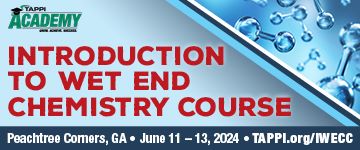 Search
Search
Use the search bar or filters below to find any TAPPI product or publication.
Filters
Content Type
Publications
Level of Knowledge
Collections
Journal articles

Magazine articles

Dynamic out-of-plane compression of paperboard — Influence of impact velocity on the surface, TAPPI Journal February 2024
ABSTRACT: Processes that convert paperboard into finished products include, for example, printing, where the paperboard is subjected to rapid Z-directional (ZD) compression in the print nip. However, measuring and evaluating the relevant properties in the thickness direction of paperboard are not necessarily straightforward or easy. Measuring at relevant, millisecond deformation rates further complicates the problem. The aim of the present work is to elucidate some of the influences on the compressive stiffness. Both the initial material response and the overall compressibility of the paperboard is studied. In this project, the effect on the material response from the surface structure and the millisecond timescale recovery is explored.The method utilized is a machine called the Rapid ZD-tester. The device drops a probe in freefall on the substrate and records the probe position, thus acquiring the deformation of the substrate. The probe is also allowed to bounce several times on the surface for consecutive impacts before being lifted for the next drop. To investigate the time dependent stiffness behavior, the probe is dropped several times at the same XY position on the paperboard from different heights, thus achieving different impact velocities. The material response from drops and bounces combined allows study of the short-term recovery of the material. The material in the study is commercial paperboard. The paperboard samples are compared to material where the surface has been smoothed by grinding it. Our study shows that there is a non-permanent reduction in thickness and a stiffening per bounce of the probe, indicating a compaction that has not recovered in the millisecond timescale. Additionally, a higher impact velocity has an initial stiffening effect on the paperboard, and this is reduced by smoothing the surface.
Journal articles

Magazine articles

A hundred years of corrosion in the pulp and paper industry, TAPPI JOURNAL May 2018
A hundred years of corrosion in the pulp and paper industry, TAPPI JOURNAL May 2018
Journal articles

Magazine articles

Laboratory method for determining the source of brightness loss at a southern United States bleached paperboard mill, TAPPI Journal October 2018
Laboratory method for determining the source of brightness loss at a southern United States bleached paperboard mill, TAPPI Journal October 2018
Journal articles

Magazine articles

Fundamental molecular characterization and comparison of the O, D0, and E stage effluents from hardwood pulp bleaching, TAPPI Journal 2019
ABSTRACT: The present study characterized effluents from the O, D0, and E stages using nuclear magnetic reso-nance (NMR) and gel permeation chromatography (GPC) techniques to better understand the chemical nature of the dissolved organics formed from the bleaching of a high-yield hardwood kraft pulp. Understanding the structures and molecular weight distribution of these organics is the first step in developing methods to mitigate these contam-inates in the discharged effluents. The results indicated that the molecular weight distribution (MWD) of the dis-solved organics from oxygen delignification effluent is broader than those from D0 and E stage effluents. In addition, the O stage filtrate contained considerable amounts of lignin and xylan fragments, which showed its efficiency in removing such materials. The effluent from the D0 stage contained a lower amount of high molecular weight frag-ments and a higher amount of low molecular weight fragments versus the O-stage filtrate. Aromatic structures were nearly absent in the D0 stage filtrate, but the degraded organic material, presumably from oxidized lignin, contained olefinic (C=C) and carbonyl (C=O) functional groups. Furthermore, higher molecular weight fragments were detected in the E-stage effluent, presumably due to the extensive solubilization and removal of the oxidized lignin generated from the D0 pulp.
Journal articles

Magazine articles

Comprehensive fault detection and isolation method applied t
Comprehensive fault detection and isolation method applied to a recovery boiler, TAPPI JOURNAL May 2016
Magazine articles

Treatment efficiency of eucalypt kraft pulp bleaching effluents: influence of dissolved organic matter, SOLUTIONS! & TAPPI JOURNAL, April 2002 (128KB)
Treatment efficiency of eucalypt kraft pulp bleaching effluents: influence of dissolved organic matter, SOLUTIONS! & TAPPI JOURNAL, April 2002 (128KB)
Magazine articles

Barbara Dalpke: insights from a recent graduate, TAPPI JOURN
Barbara Dalpke: insights from a recent graduate, TAPPI JOURNAL, August 2002, Vol. 1(6) (144KB)
Magazine articles

Drying: New lime mud dryer kiln helps James Riverâ??s Pennington, AL, mill meet environmental restrictions, December 1995 Tappi Journal [95Dec37.pdf]
New lime mud dryer kiln helps james river's pennington, al, mill meet environmental restrictions, TAPPI JOURNAL, December 1995, Vol. 78(12)
Magazine articles

China: now and in the future, TAPPI JOURNAL, May 1996, Vol. 79(5)
China: now and in the future, TAPPI JOURNAL, May 1996, Vol. 79(5)
Magazine articles

Capital cost analysis looks at recent and future trends, TAPPI JOURNAL, November 1992, Vol. 75(11)
Capital cost analysis looks at recent and future trends, TAPPI JOURNAL, November 1992, Vol. 75(11)






